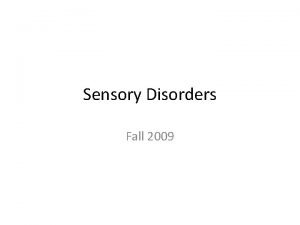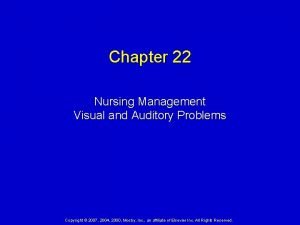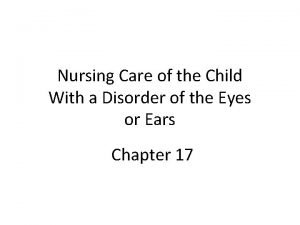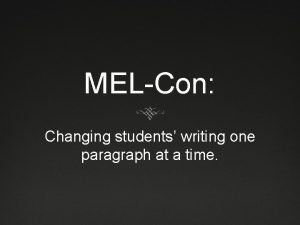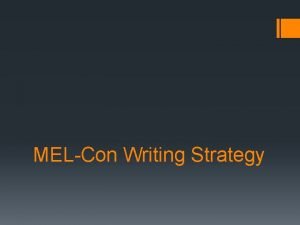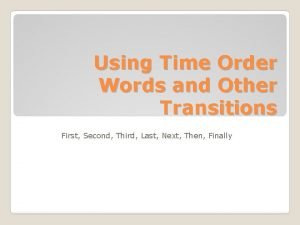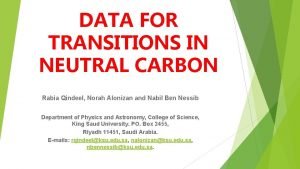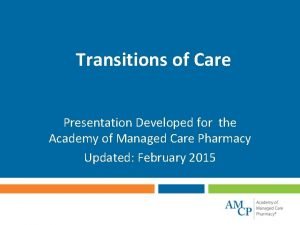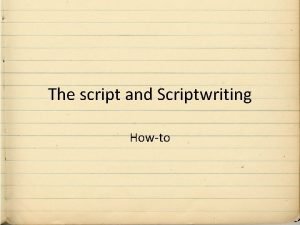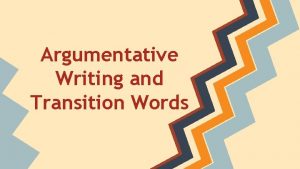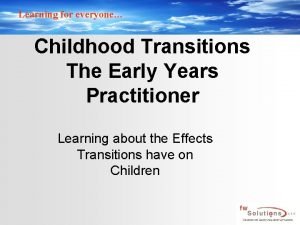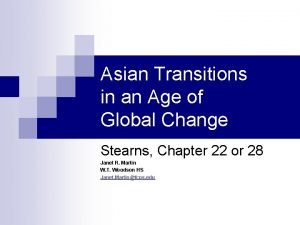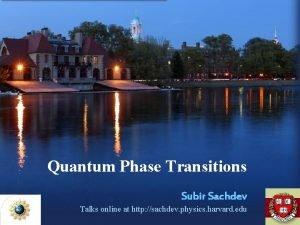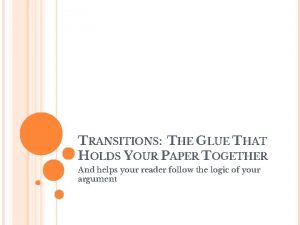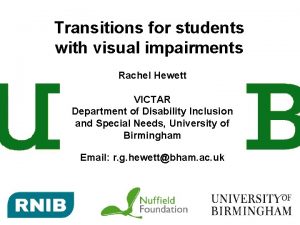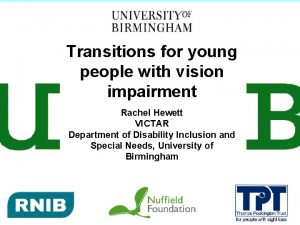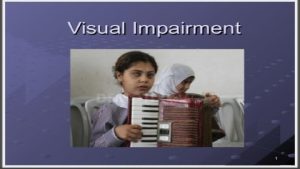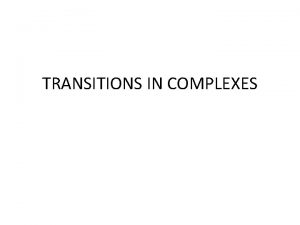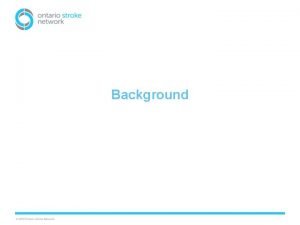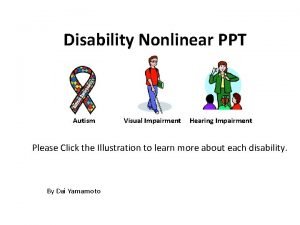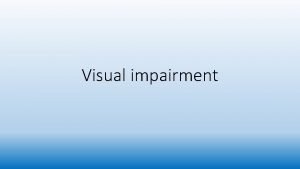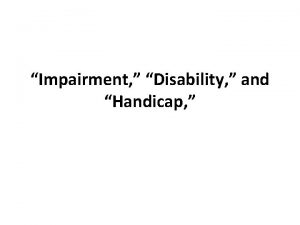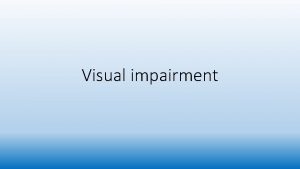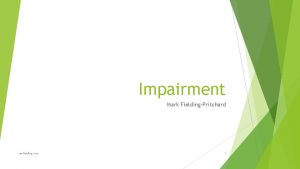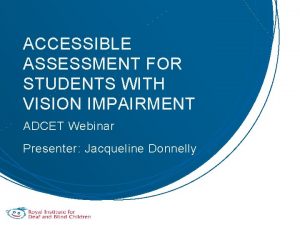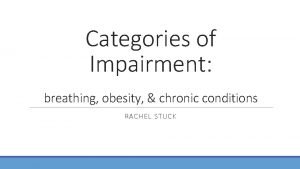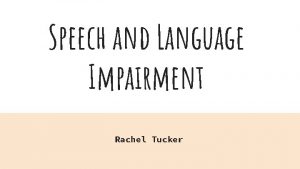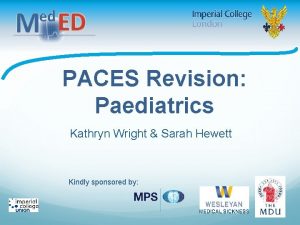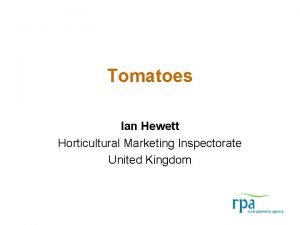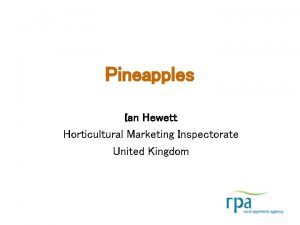Transitions for students with vision impairment Rachel Hewett






















- Slides: 22

Transitions for students with vision impairment Rachel Hewett VICTAR Department of Disability Inclusion and Special Needs, University of Birmingham Sue Keil Children, Young People and Families (CYPF) team RNIB

Background to the project o Five-year longitudinal study – Phase one funded by RNIB – Phase two funded by Nuffield Foundation o Tracking the experience of over 80 young people with vision impairment through post-14 transition

Background to the project o Concerns relating to the transition experience of young people with visual impairments – how well is education preparing them for adult life? o Research findings show that the employment rate of people with visual impairments in the UK is very low o Recent secondary data analysis of the UK labour force survey suggests that 44. 4% of 16 -25 year olds with vision impairment are not in education, employment or training (NEET)

Longitudinal Study o 82 participants recruited through local authority sensory support services. At the time they were aged 13 -16. Now they are aged 18 -21. o We have collected data on their experiences twice a year o Themes explored include: details of their vision impairment; educational experiences; access to exams; accessing information; use of technology; independence skills; self-advocacy skills; disability related benefits

Participants Characteristic Gender Preferred reading format Type of school at time of recruitment Total (N) Total (%) Male 37 45% Female 45 55% Normal to large print (pt 12 -17) 37 45% Large print (pt 18 -27) 27 33% Very large print (pt 28+) 4 5% Braille 14 17% Mainstream/mainstream school with attached resource base 66 80% Special school 16 20%

Participants Characteristic Additional Special Needs Statement of Special Educational Needs Cohort recruited into Total (N) Total (%) Yes 13 16% No 58 71% Unknown 11 13% Yes 54 66% No 18 22% Unknown 10 12% Year 9 30 37% Year 10 6 7% Year 11 46 56%

Where are our participants now? (Autumn 2014) What is the participant doing currently? Participants (N) Participants (%) University 29 40% FE/Sixth form 15 21% Employed 14 19% Unemployed 6 8% Gap year 3 4% Voluntary work 2 3% Maternity leave 1 1% Apprenticeship 1 1% Currently unknown 2 3% Total 73 100%

Preparation for transition from school: key themes o Independent learning – access to written information o Independent living – mobility and independence skills o Information needs – careers advice, DSA, Access to Work o Churning, NEETs – vulnerability factors o Next steps – proposed resources, tracking the YP into employment

Independent learning: accessing information – Low vision aids o Just over half the participants had used low vision aids at school, and while some saw the benefits, many spoke of difficulties in using them “I think they helped me quite a lot. I think I would have struggled a lot more without them, because that was the time that we were introduced to the fact that we would be doing a lot of reading…books and things like that, it was difficult to enlarge them or anything like that. ” – “Magnifiers are the worst things that have ever been invented. They’re just… Cos you’re focusing on one part and by the time you’ve got to the next part you miss half a line and you miss these bits and these bits. It’s just absolute hell!” o

Independent learning: accessing information – Low vision aids o Few of the participants received LVAs through low vision clinics – evidence some were given aids inappropriate to their needs and have discounted LVAs altogether o Gap in knowledge – evidence that those who were given LVAs in school rather than through low vision clinics do not know where to go to get LVAs now that they have left education

Independent learning: accessing information o 20 participants use braille o More favourable outcomes for those who were taught braille at a very young age – “It was good cos I could already read it and everything. I was never behind academically because of having to learn braille. So that was good. Basically I could go to primary school and I only had to learn grade 2 but in effect I could get any work that we were given and I could still read it. ” o Specific circumstances where participants would favour braille over electronic material – choice is important

Independent learning: accessing information - technology o Movement by the young people away from using specialist software towards making adjustments to mainstream equipment – “I turn the screen resolution to 600 x 900 I think it is. Basically it makes things a bit bigger. ” o Participants making use of mainstream devices which have inbuilt accessibility options – I use an i. Pad in my placement for my notes. You can adjust the brightness and the darkness. Can enlarge things when they need enlarging. You can do all kinds of things with it – it’s the best thing I’ve ever had.

Independent learning: accessing information Question of whether mainstream technology alone be sufficient when in the workplace. o Important that the young people have a range of methods for accessing information o Thinking beyond what skills are needed to access the curriculum o

Independent living: mobility skills o In general limited mobility training for participants who did not attend specialist schools. Some who struggled in getting around independently had never even heard of mobility training – “I had a bit of mobility. It must have been, it was so infrequent. So when I was in Year 10, I would have mobility once every two weeks. And then for some reason in Year 11 it completely stopped. And then funny enough, during the summer holiday, in between Year 11 and Year 12, I had mobility twice, in six weeks. I don’t know if it was because I wasn’t picking up the routes, or that it was infrequent, or if the mobility teacher wasn’t… I just didn’t find it helpful at all, I didn’t learn anything. ”

Information needs o Careers advice – mixed response towards careers advice previously received, with some reacting badly to receiving advice from people they felt ill-equipped to do so: – “They tried, but I said no! They are from Connexions, and I am like, Connexions sort of advise everyone, they don’t know anything about my visual impairment and like they are probably just going to go onto Google and do some research that I could do in my spare time. o Access to Work - two thirds hadn’t heard of Access to Work scheme & despite 14 participants being in employment/apprenticeships, none of have requested an access to work assessment. Limited engagement with this scheme.

Information needs: Disabled Students Allowance o Problems identified in the Disabled Student Allowance process, at all stages of application, some of which came down to limited specialist support provided when going through DSA assessment process

Churning, NEETS: vulnerability factors Evidence of “churning” amongst some participants – Some not prepared to move into labour market – repeating courses – Others have had difficulties on courses and repeated course/taken a new course at same level o NEET (Not in Employment, Education or Training) – 6 participants who could be described as NEET – Tended to be those who did not achieve sufficient qualifications to continue to higher education – Three participants long term NEET all registered as blind o

Next steps: developing resources o Develop a series of resources designed to provide tailored practical guidance for: – young people with VI – Those providing direct help and services (e. g. parents, teachers, FE and HE providers, employment and rehabilitation officers) – Employers, private and public service providers, policy makers o YP involved in piloting and evaluation

Next steps: tracking the YP into employment o Continue tracking our cohort of young people as they follow their transition journey into adulthood. o We intend to focus particularly on: – their experiences of looking for employment, – their experiences as they seek to live independently

Further information o Project website: http: //www. birmingham. ac. uk/research/activity/educatio n/projects/transitions-study. aspx o VICTAR website: http: //www. birmingham. ac. uk/research/activity/educatio n/victar/index. aspx o RNIB website: http: //www. rnib. org. uk/knowledge-and-research-hubresearch-reports/education-research

Contacts: o Rachel o Sue Hewett: r. g. hewett@bham. ac. uk Keil: sue. keil@rnib. org. uk

Acknowledgements o Project team – Graeme Douglas, PI o Funders – Royal National Institute of Blind People – Nuffield Foundation
 Nursing diagnosis for vision impairment
Nursing diagnosis for vision impairment Nursing diagnosis for meniere's disease
Nursing diagnosis for meniere's disease Nursing care plan for conjunctivitis slideshare
Nursing care plan for conjunctivitis slideshare Cataract surgery nursing care
Cataract surgery nursing care Cerebrovascular accident
Cerebrovascular accident Champion of filipino students
Champion of filipino students Human vision vs computer vision
Human vision vs computer vision What is a melcon paragraph
What is a melcon paragraph Finite automata with epsilon transitions
Finite automata with epsilon transitions Mel-con paragraph examples
Mel-con paragraph examples Rame tep meaning
Rame tep meaning What are time order words
What are time order words How to use windows live movie maker
How to use windows live movie maker Rabia transitions
Rabia transitions National transitions of care coalition
National transitions of care coalition Script writing elements
Script writing elements Dr christine weller
Dr christine weller Argumentative essay structure
Argumentative essay structure Effects of transitions in early years
Effects of transitions in early years Asian transitions in an age of global change
Asian transitions in an age of global change Subir sachdev quantum phase transitions
Subir sachdev quantum phase transitions Flocabulary transitions
Flocabulary transitions Conclusion transitions
Conclusion transitions
